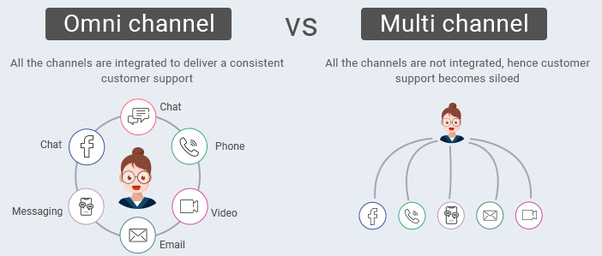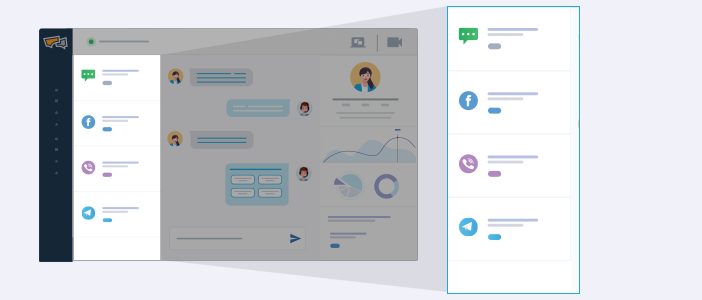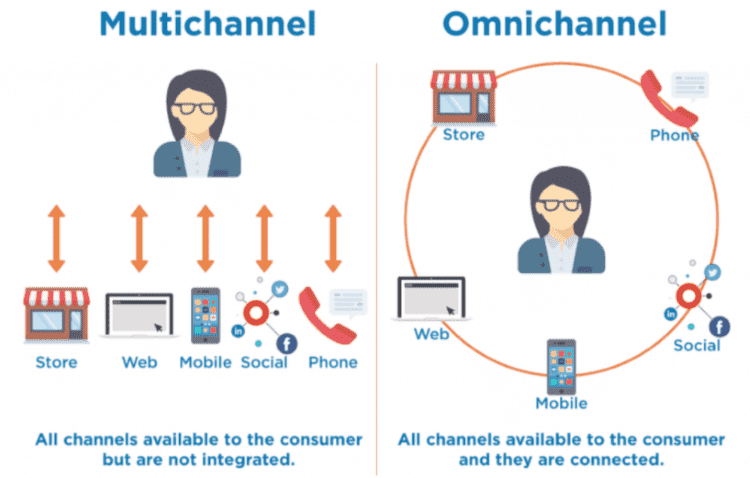Omnichannel vs. Multichannel: What is The Difference?
- April 27, 2020
- 13 mins read
- Listen

Table of Content
Many businesses face challenges in understanding customer insights about their behavior or sentiments. They have a negligible idea about how the discovery happened and what are the customer actions across multiple interactions with your brand so that you can have better consistent engagement.
The important aspect of understanding an omnichannel vs multichannel strategy is which one fits better for your business. Companies with omnichannel customer engagement strategies retain on average 89% of their customers.
Knowing the key difference between a multichannel vs omnichannel approach can help to gain better insights or behavioral data about your customers’ journey.
What is a multichannel approach?
Multichannel marketing refers to the customer interaction strategy combining both indirect and direct communication channels like websites, retail stores, catalogs, email, mobile, etc. The goal is to encourage customers to take action in response by using their preferred channels.
Deploying multiple channels empowers customers to choose the convenient channel to interact with a brand. It boosts brand presence making it easier for the customers to reach out to the brand for support.
What is an omnichannel strategy?
Omnichannel strategy streamlines all the conversations under one platform across all channels like website, social media, email, phone, etc. and helps to gain a better understanding of customer behavior by mapping their journey to deliver consistent customer service.
Being omnichannel means seamless interaction across any customer touchpoint of their journey starting from pre-sales to post-sales and everything in between.It is all about providing a personalized and cohesive customer experience.
However, Both the strategies involve reaching out to customers in many ways, knowing the key differences between multichannel vs omnichannel approach helps to make the right decision.
Multi-channel vs omnichannel marketing: What’s the difference?
Choosing any one of the approaches depends on your business sector, size, and audience. Understanding the omnichannel multichannel difference helps to connect all the touchpoints to deliver a consistent customer experience.

Here are the major differences between omnichannel vs multichannel marketing to understand the right fit for your business.
Channels vs. Customers
Omnichannel customer care is a holistic approach that connects all channels to engage with customers ensuring a seamless brand experience across every channel. It aims at developing a stronger business-customer relationship.
Whereas the multichannel approach aims at enabling customers to reach the brand via a maximum number of channels. It adopts two or more channels to engage customers and the most popular are social media & email.
Uniformity vs. Engagement
The omnichannel strategy ensures that customers are satisfied with getting the unified messaging experience through every channel. Having a consistent brand experience enhances engagement and relationship with the brand.
Being omnichannel needs to make sure that all the internal departments are in tune with your brand messaging. It helps to deliver a cohesive engagement across all channels to make the strategy successful.
However, in the multichannel strategy, customer engagement is siloed.
Hyper Personalization
The omnichannel marketing strategy collects and analyzes customers’ data to understand their pain points, which requires more effort to deliver a hyper-personalized experience.
While the multichannel approach conveys the brand message and motivates customers to use the call to action (CTA). With an omnichannel strategy, you put extra effort into understanding customer journeys better to serve with personalized solutions.
Effort vs. Unified
Omnichannel marketing aims at fostering an effortless support or buying experience for consumers. It uses analytics to obtain insights to engage customers easily. With a multichannel strategy, it doesn’t happen.
The significant difference between multichannel vs omnichannel is that the latter connects the touchpoints together so that, whatever journey the customer chooses to take, the experience is consistent and unified.
What are the key benefits of omnichannel?
When customers don’t get enough channels or there is no seamless transition, it creates friction and impacts the customer’s experience. Usually, shoppers who buy through multiple channels have a 30% higher lifetime value than others. By implementing an omnichannel strategy you can exemplify customer experiences.
Here are the key benefits of an omnichannel communication approach.
1. Higher return of investment (RoI)
Businesses choosing an omnichannel approach are likely to make significant investments in advanced technology and tools. Implementing the latest tools needs to integrate it right across the business systems.
It involves a broader vision by businesses and needs to be driven from the very top for it to be successful. However, investing in customer engagement strategies results in a higher RoI in the long run. The significant benefits witnessed by the businesses are:
- Lesser touchpoints – The strategy empowers your agents to understand customers’ concerns faster and provide effective solutions in the first go. This improves the first call resolution (FCR) metric and reduces the number of touchpoints.
- Higher satisfaction – When customers receive quick feasible solutions with the right systems and technology in the first contact, the satisfaction level increases. It improves the lifetime value of the customer (CLTV) significantly.
2. Streamline conversations under one platform
You can leverage an omnichannel customer engagement platform to unify all your customer conversations in one place to understand your customer journey better. By analyzing it you can gain deep insights to personalize engagement with customers across all touchpoints.

You need to be where your customers are. By being active on the preferred touchpoints you can offer real time engagement and improve customer experience.
Here are the key steps to create an omnichannel customer experience:
- Map your customer journey – It helps to understand your customer needs better and use the insights to create strategies to engage them better across all touchpoints.
- Identify the preferred channels – Know what are the frequently used channels by your customers to connect with you. Be active where your customers are to deliver a great experience.
- Build the right strategy – By using the customer insights and knowledge about channels, build the right strategy to deliver a seamless experience across channels.
- Identify the gaps – Know the gaps in your communication strategies or the fragmented experiences and bridge the gaps to deliver the best omnichannel experience.
3. Understand your customer journey to gain insights
The omnichannel strategy helps to gain valuable insights into previous interactions made by customers with your brand. It helps to use customer journey maps to meet customer needs and deliver an optimal omnichannel experience.
Knowing customers’ behavior helps to optimize your processes to reduce customer frustration, bridge the gaps in the process, and nudge them towards conversion.
How does mapping customer journey help to create a great omnichannel experience?
- Identify the touchpoints – You can understand the major touch points where your customers need your assistance and be actively present to engage them.
- Take proactive actions – Understanding all touchpoints will help you to act proactively across the behavioral stages of the customers.
- Create processes – You can define specific strategies to deliver effective real time support with the right channel to improve customer experience.
- Develop self-service options – Having self-service options such as tutorials, videos, etc. helps customers to find solutions before they reach you.
- Collect customer feedback – Regularly ask your customers feedback, share with the relevant teams, and continuously improve the gaps.
4. Better team productivity
Generally, a lot of time is involved in resolving a single issue by having many back and forth conversations with the customers. Omnichannel dashboard empowers your team with real time feedback about their interactions on their customer interactions handled on each channel.
Being omnichannel helps to meet the key KPIs to improve team performance. The key metrics are First Contact Resolution (FCR), Total Resolution Time, Average Response Time, and Missed Conversations.
How omnichannel improves agents performance and increases team productivity
- Less touchpoints = Less complexity – The insights help to understand the customer journey better and all departments have to be constantly aligned to deliver personalized solutions at the first touchpoint.
- Time & resources – When the FCR is improved you are able to solve more queries by improving the average response time. You can manage and resources accordingly across business functions.
5. Boost your customer retention
An omnichannel strategy connects all the channels and helps to gain a better understanding of customer behavior by analyzing their journey to deliver consistent support. Omnichannel customers are 30% more valuable to your business over the course of their lifetime.
Brands that make the effort to engage their audience with an omnichannel avoid attrition and act as one of the customer retention strategies of your business. Omnichannel communication strategy empowers customers to connect with the brand through their preferred channel and also make a smooth transition in the same interaction.
When businesses open all the gateways for the customers to connect with time, customers find it most convenient and tend to retain your business for a longer time.
6. Deliver a unified customer experience
Users choose online and offline channels like live chat, Facebook messenger, kiosks, or visiting storefronts or service centers to engage with businesses. Creating consistency among every channel improves the experience as well as the brand image.
The omnichannel customer service strategy focuses on delivering a seamless experience across all the channels. It means the channels are centralized under one platform to bring stability, ensuring consistency across the board. The experience is the same regardless of the touchpoints used by the customer.
Here are the key benefits of consistent omnichannel experience:
- Connects with the customers in real time across their preferred channels and reduces the average response time.
- Improves customer satisfaction by using insights to provide effective solutions in the first go and improves first contact resolution (FCR) rate.
- Provide valuable insights about the customer profiles analyzing their journey to get a better understanding of customer needs and interests.
Omnichannel vs. multichannel retailing
The omnichannel retail approach integrates the customer experience across all sales and marketing channels from eCommerce, in-store, and mobile apps to social media, email, and loyalty marketing. Multichannel retailing allows customers to purchase goods and services in many ways without integration.
87% of retailers agree that an omnichannel strategy is critical or very important to their success.

The omnichannel retail strategy delivers a seamless experience from the customer’s perspective. Every way a buyer interacts with a company from online, in-store, mobile app, their user experience (UX) connects. Multichannel retailing doesn’t create an omnichannel experience.
In order to create such an experience, your sales channels, payment methods, and other aspects of your business must connect so that no matter how your buyer interacts with your company, it’s seamless to them. Omnichannel retail is considered to be customer-centric.
Multichannel vs omnichannel eCommerce
HBR’s study found that customers of omnichannel companies are more valuable on multiple counts. If you have made up your mind between omnichannel vs multichannel, you need to consider for a successful shift from one strategy to another.
Here are four great ways to make the omnichannel strategy work with your business.
Omnichannel vs multichannel – How to make a shift towards omnichannel?
Harvard Business Review found that customers of omnichannel companies are more valuable on multiple counts. If you have made up your mind between omnichannel vs multichannel, you need to consider for a successful shift from one strategy to another.
Here are four great ways to make the omnichannel strategy work with your business.
1. Be data driven
Getting customer behavioral insights is imperative for omnichannel success. Customer journeys need to be analyzed via digital and physical channels to deliver a personalized experience. Shifting to an omnichannel strategy helps to obtain in-depth insights into customer engagement.
Analytics enables businesses to target customers with the right message that matches their needs. When you target customers based on data, their conversion rates go higher.
Key benefits of data analytics are as follows:
- Identify customer needs – A deeper understanding of customer requirements which, in turn, builds better business relationships.
- Recognize the opportunities – It provides the ability to make faster, more informed business decisions, backed up by facts for up-selling.
- Measure customer satisfaction – The analytics help you to monitor whether the strategies are able to engage customers the right way or not.
- Know customer behavior – By using predictive analytics you can identify future trends in consumer behavior.
2. Invest in system & tools
Effective customer engagement is one of the major goals of every business. Using the right system and tools helps your business to engage customers interactively and deliver delightful customer service. The advanced customer engagement tools help you to actively involve customers with your business to resolve their issues and provide faster solutions.
How does investing in tools & systems help to serve customers better?
- Chatbots are becoming a must-have technology for retailers and eCommerce stores, as they can help users to get the answers and the solutions, without having to leave the website or wait for a response via email or phone.
- Digital customer engagement tools like live chat, video chat and co-browsing you can interact with customers in real time directly or by sharing the browser screen to identify the issue faster and resolve it successfully in the first contact.
3. Know your customer journey
When you move to an omnichannel approach, you will be able to understand your customers better. You will be able to know their wants, needs, and preferences. It further helps your business to build your product and services to match their interests.
Learning about how customers interact with you and what are their objectives for each interaction. Understanding the areas will help you to meet those objectives in the most efficient manner. You can customize interactions to serve your customers better and boost satisfaction.
How can you understand your customers better?
- Acquire customer feedback – To know customers’ perceptions and opinions towards your brand.
- Use analytical data – The data helps to know what your customer wants and needs so that you can match your product or services accordingly.
- Social listening tools – Monitor the comments, posts, complaints made by customers across your social channels and promptly act on it.
Omnichannel vs multichannel: The future
In a nutshell, the objectives of both omnichannel and multichannel marketing strategies aim to reach potential customers across multiple channels. With the rising customer expectations and technology advancement, businesses shifting to the omnichannel strategy will become vital.
It provides customer insights that have great value for any business. Using the data helps them to determine future strategies, acquire customers with a customized approach, targeted offers as well as communication channels, and lead to higher conversion.
While choosing between omnichannel vs multichannel, businesses should make the shift to focus on omnichannel efforts in order to increase customer retention and revenue.



